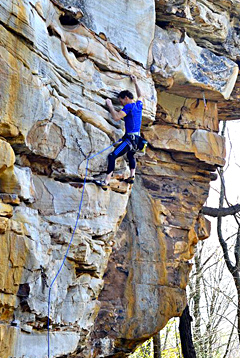The “10-4 Rule” – A Guideline for Projecting (and Steady Improvement)

The author sending his mini-project, Eye of Mordor (5.13a), Meadow River Gorge.
In a recent podcast interview with Neely at TrainingBeta, one topic she asked my opinion on was the amount of time (and number of redpoint attempts) a person should invest into a project route before taking a break. It’s a common question I get asked, and my answer (with a few caveats) is that it’s best not to get bogged down by long-haul projects.
My projecting guideline for weekend warriors is what I call the “10-4 Rule”—that’s ten redpoint attempts over four days. Personally, I halve these amounts and, thus, limit myself to a total of about five attempts over two days.
Here’s the reasoning behind my “10-4 Rule.”
1. Climbing is a skill sport first and foremost. Therefore, climbing a high volume of terrain is the fastest way to learn new skills, improve economy of movement, and dial in your mental game. Conversely, climbing the same 50 or 100 feet of rock, over and over, climbing day after climbing day, will actually stunt your technical growth. (Imagine a basketball player who only practiced, say, foul shots—long term, he’ll excel at making that one shot, but he’ll be a poor player from other locations and distances on the court.) The cliffs of the world present us with an infinite playing field, and so to dominate at climbing you must climb and “practice” widely.
2. Confidence and a positive mindset is critical for improving your climbing performance, yet failing on a route repeatedly over many days is a real confidence and good-mood killer. Building confidence comes from sending; therefore, selecting cool routes that you can onsight, flash, or send in a few goes is the pathway to multiplying confidence and having a heck of a lot of fun!
3. A couple of research projects have hinted that gains in efficiency via repeated attempts on the same climb begins to level off between three and ten attempts. Elite climbers often refine sequences to the point of high efficiency in just a few attempts, whereas non-elite climbers may need many more attempts before gains in efficiency become negligible. The bottom line: if you’ve dialed in the sequence and become about as efficient as you can be (~10 attempts) and you still can’t send the route, then you likely need to get stronger in order to bag the redpoint. A few weeks of targeted training (what’s your limiting constrain on the project?) might be all that’s needed to send the rig!!
When should you break the 10-4 Rule? Here are five good reasons to give your proj more time and attempts. 1. The route is extremely complex or the crux is a low-probability dynamic move. 2. You’re near the end of a roadtrip and the redpoint feels imminent given a few more goes. 3. Your project is at a local crag—close enough so that you can do your targeted physical training on the route! 4. On your 9th go (or whatever) you discover a game-changing rest (knee bar, hand jam, etc.) or an easier way to navigate the crux. 5. If you’re a pro climber with almost unlimited opportunity to climb outside.
Interestingly, German rock star Alex Megos has made quick ascents his MO–with just a few exceptions, Alex sends routes in just a few goes and eschews long-term projecting. Years of employing this quick-send approach to cragging (similar to my 10-4 Rule) has helped turn Alex into one of the world’s best climbers!
Let me leave you with a crag climbing guideline that you might call the 80-20 rule. Spend 80 percent of your outdoor climbing time on routes that you can onsight, flash, or second-go, and limit hard projecting (routes taking 3+ attempts) to 20 percent or less. This way, you’ll get the high volume of sends you need to build skills and confidence, and you’ll more often than not leave the crag with that indescribable climber’s high!
Copyright 2015 Eric J. Horst. All Rights Reserved.

